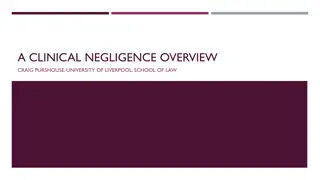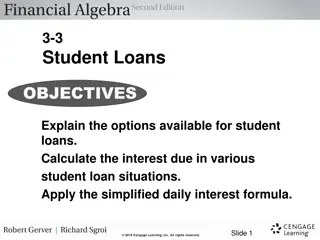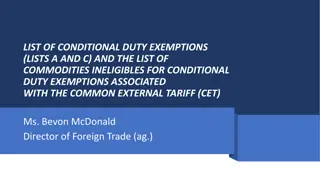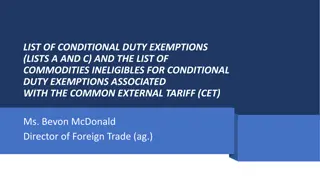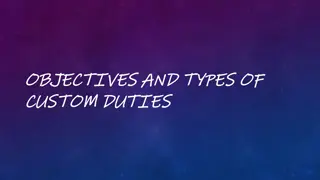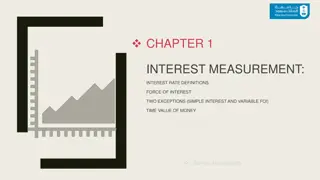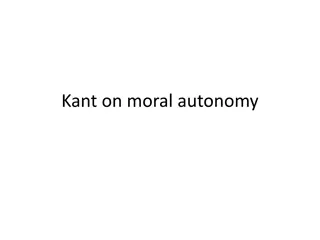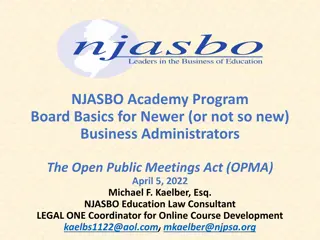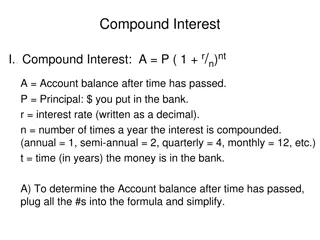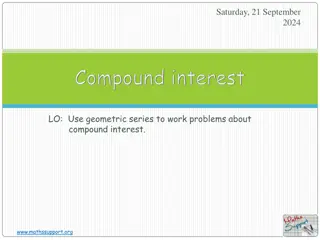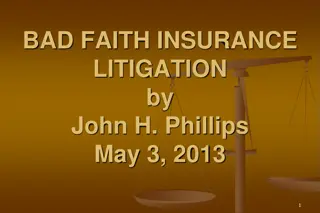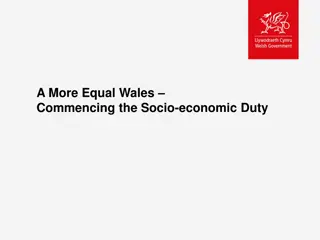Understanding the Duty to Act in the Public Interest in Legal Context
The concept of the duty to act in the public interest, as applied in legal settings, involves delegated responsibility by the public to regulatory bodies or decision-makers. This duty entails exercising judgment and discretion founded on a cultural consensus and public trust. Despite limited guidance from case law, decision-makers are expected to interpret the public interest within legislative and social contexts, ensuring decisions are fact-based, consistent with statutes, and made without arbitrariness.
Download Presentation

Please find below an Image/Link to download the presentation.
The content on the website is provided AS IS for your information and personal use only. It may not be sold, licensed, or shared on other websites without obtaining consent from the author. Download presentation by click this link. If you encounter any issues during the download, it is possible that the publisher has removed the file from their server.
E N D
Presentation Transcript
Freya Kristjanson Wardle Daley Bernstein Bieber LLP *Adapted from original presentation with Zeynep Onen, Law Society of Upper Canada, 2014 SOAR Conference Wardle Daley Bernstein Bieber LLP
1. What is the duty to act in the public interest? 2. How does a regulator/adjudicator determine what is its specific focus concerning the public interest(s)? 3. Are there best practices regarding including public interest(s) in regulatory or tribunal processes? 4. How to resolve conflicting duties or elements of the public interest(s)? Wardle Daley Bernstein Bieber LLP
The requirement to act in the public interest Delegated responsibility by the public to the regulator/ administrative decision- maker ( DM ) Delegated exercise of judgment and discretion Public trust in the license or other brand Founded on a cultural consensus Wardle Daley Bernstein Bieber LLP
Limited guidance from case law SCC in R. v. Morales: As currently defined by the courts, the term public interest is incapable of framing the legal debate in any meaningful manner or structuring discretion in any way SCC in R. v. Sparrow We find the public interest justification to be so vague as to provide no meaningful guidance and so broad as to be unworkable as a test . Wardle Daley Bernstein Bieber LLP
"While both sides took great pains to couch their arguments in terms of the public interest, this court is not the proper forum for that debate. Questions of what policy choices the City should make or how the regulatory environment ought to respond to mobile communications technology changes are political ones. Such questions are, of course, the stuff of democracy. While democracy can be a messy business, our system wisely recognizes that the perfect must sometimes yield to the practical at the risk of a wrong turn or two along the way. Courts determine disputes in the light of the output of the political process and with all of the respect for the differing opinions of the actors that our constitutional order demands." 126 OR (3rd), page 404, para 13 Wardle Daley Bernstein Bieber LLP
Public Interest must be interpreted in light of the legislative history of particular provision, and the legislative and social context in which phrase is used Decision-makers must base their decisions on the facts of the case, must be consistent with terms and purpose of statute, and not act in an arbitrary manner Common law guidance re discretionary decisions Wardle Daley Bernstein Bieber LLP
Take into consideration the concerns of society generally, or at least those concerns relevant given the statutory scheme, and not merely the interests of one segment of society Equality and human rights values properly form part of the determination of what constitutes the public interest Dor obligation to take Charter values into account in all administrative decision-making (also Taylor-Baptiste v. OPSEU, 2015 ONCA 495) Wardle Daley Bernstein Bieber LLP
Process: Focus on fair procedures Majority Opinion: what a significant majority of Canadians think about an issue Utilitarian: balance different interests to arrive at a solution that maximizes benefits for society as a whole, compromises direct interests Common Interest: Public goods like clean air, water, defence, public safety Shared Values: diversity, equality, participation, dignity Wardle Daley Bernstein Bieber LLP
Process Values Opinion Common Good Interests Wardle Daley Bernstein Bieber LLP
Statutes and Regulations Explicit/implicit General/specific Regulatory Tool Box Mission Statement Rules, Policies, Guidelines Strategic Plan/Business Plan/Priorities General: Charter, Human Rights Code, Privacy Adjudicative Decisions Wardle Daley Bernstein Bieber LLP
Governing legislation may contain explicit provisions Example: Law Society Act section 4.2 paragraph 3 The Society has a duty to protect the public interest Wardle Daley Bernstein Bieber LLP
Regulated Health Professions Act 36. (1) [Keep confidential all information that a person learns in the course of their duties except] . (g) to confirm whether the College is investigating a member, if there is a compelling public interest in the disclosure of that information Health Professions Procedural Code 2.1 It is the duty of the College to work in consultation with the Minister to ensure, as a matter of public interest, that the people of Ontario have access to adequate numbers of qualified, skilled and competent regulated health professionals. 3(2) (2) In carrying out its objects, the College has a duty to serve and protect the public interest. Wardle Daley Bernstein Bieber LLP
Implicit provisions in the governing legislation based on the powers granted to the regulator/DM. In other words What are the express legislated duties do they by implication define the public interest mandate? For example, the authority to license implies protection of the pubic interest by selecting competent and ethical individuals Wardle Daley Bernstein Bieber LLP
Regulators Policy making: Articulation of a regulator s policy objectives in policy development and in policy documents Express mandate: Setting out an express mandate or mission statement for the regulator or admin DM to capture its public interest role Example: OSC Women on Boards Wardle Daley Bernstein Bieber LLP
Chairpersons Guidelines in Four Circumstances: 1. Specific legal issues (emerging issues, resolve ambiguity, resolve inconsistency) 2. Provide guidance on questions of mixed fact and law (e.g. aspects of country conditions) 3. Codify the exercise of discretion 4. Guidance on procedural issues Wardle Daley Bernstein Bieber LLP
The definition of the public interest(s) should be consistent across all tools in the regulatory tool box Consistent with stakeholder communications, communications with Minister, public communications Will infuse all elements of regulatory processes Wardle Daley Bernstein Bieber LLP
Failure to meet the mandate to regulate in the public interest = significant risks Stakeholder confidence Public confidence Confidence of Board, Minister Reputational risk Litigation risk (regulatory negligence) Wardle Daley Bernstein Bieber LLP
Regulatory audit (public interest focus): examine all aspects of the organization are we doing everything we should be doing under the legislation? Assessing risk: What aspects of our processes create risk? Enterprise risk management public interest Wardle Daley Bernstein Bieber LLP
Inquiries, Complaints, Call Centres receipt and response to complaints triage function: jurisdiction; referral; documentation; delay Case Assessment appropriateness of case assessment criteria public interest; application of case assessment appropriate consideration of statutory powers, duties, options past complaints and continuing activity of licensee/registrant delay Wardle Daley Bernstein Bieber LLP
Investigations Prosecutions Adjudication Rules Policies Guidelines Wardle Daley Bernstein Bieber LLP
Communication: a necessary component of working in the public interest Staff policies and training Scanning the environment/ stakeholder relations Shifting public interest demands: a moving target Wardle Daley Bernstein Bieber LLP
Mission Statement Strategic Plan/Business Plan Statement of Priorities Governance Charter and Skills Matrix: Composition of Board/Commission Do you have the capacity to regulate in the public interest? Conflict of Interest Rules Stakeholder Advisory Boards Wardle Daley Bernstein Bieber LLP
failure to use discretionary powers in good faith and for a proper purpose failure to base decision on logically probative evidence failure to consider relevant considerations/taking into account irrelevant considerations failure to observe the basic rules of procedural fairness conflict of interest, reasonable apprehension of bias improperly fettering discretion improper delegation refusing to exercise a discretionary power where under a duty to do so, or unreasonably delaying the making of a decision that the decision-maker is under a duty to make. Wardle Daley Bernstein Bieber LLP
Conflicting public interest duties Obligations to different segments of the public Balancing interests in the process Limits to the public interest Wardle Daley Bernstein Bieber LLP
Proportionate: regulators should only intervene when necessary. Remedies should be appropriate to the risk posed, and costs identified and minimised Consistent: rules and standards must be joined up and implemented fairly Targeted: regulation should be focused on the problem, and minimise side effects Wardle Daley Bernstein Bieber LLP
Questions? *Slides 8 & 9 based on Leslie A. Pal and Judith Maxwell, Assessing the Public Interest in the 21st Century: A Framework, A paper prepared for the External Advisory Committee on Smart Regulation, Canadian Policy Research Networks, January, 2004 Wardle Daley Bernstein Bieber LLP


